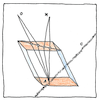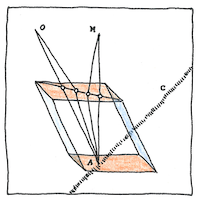Rasmus Bartholin
optics

|
Birefringence
Rasmus Bartholin observed, before Thomas Young explained that light was a wave, before Augustin-Jean Fresnel explained how light could be polarized, that light through a piece of Iceland spar suffered a double refraction. Passing through a crystal of calcite the vertical component of the light is deflected at one angle and the horizontal component is deflected at another.
Iceland spar
Transparent calcite Iceland spar Viking sunstone the calcite crystal reveals an entoptic pattern on the fovea centralis allowing one to see the sun’s direction through the clouds
Double vision
Since light waves have two components both transverse to the direction of travel and orthogonal to each other, an ordinary ray and an extraordinary ray, let it be revealed that the absence of longitudinal vibration has absolutely no spiritual significance but appears to be one of those jokes whose humor has been lost, but think again, noting that two orthogonal polarized waves cannot interfere, and so with anything— if they cannot interfere, then they can travel together.



Light’s lack of a longitudinal vibration (vibration along its direction of travel) is eventually explained by Albert Einstein—the speed of light is constant.
Many frequencies are inherent in normal, incoherent light in the range perceptible to human eyes, and each of those is a blur of ordinary and extraordinary transverse waves. Some people see ghosts, some see auras, some say they have second sight.
See also in The book of science:
Readings in wikipedia: